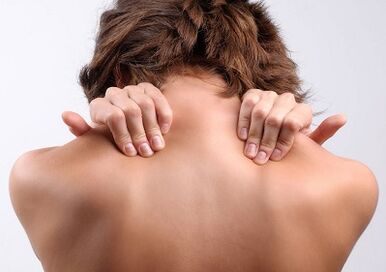
Cervical osteochondria and dizziness, fears and depression - the conditions, at first glance, are not related to each other, but this is not the case.Very often, physical condition has a significant impact on the patient's psycho -emotional state.
Statistics confirm this position - spine diseases in more than 65% of cases cause depressive conditions in patients.In addition, the same statistics suggest that in patients with osteochondria, depression develops twice as often than with other diseases (diabetes, stroke, heart attack).
In addition to depression, patients with osteochondria often have panic attacks.This is a feeling of fear that arises unjustifiably and suddenly.The attacks are short and are the result of stress reactions.There is evidence that panic attacks are more common with cervical osteochondria, such as dizziness, fears and depression.If the patient notes the appearance of this condition up to 4 times in 1 month, then this requires thorough examination and treatment.
Causes and forms of manifestation of the disease
Cervical osteochondria is a chronic and progressive disease.The cartilage fabric of intervertebral discs is destroyed as a result of inflammatory processes.
The causes of the disease are:
- heredity;
- scoliosis and inappropriate attitude.
- cervical injuries;
- hormonal imbalance.
- Rheumatism and system wolf.
- Hyphenism.
In its development, osteochondria goes through 3 stages.The first is characterized by the principle of the intervertebral disc -deformation process.There is a little discomfort and a slight pain in the throat.In 2 stages, the disaster of the discs continues, the cervical vertebrae are neutralized.The patient is pursued by a constant feeling of pain at the point of inflammatory damage.The disease begins to take years.The third stage is accompanied by symptoms such as headache and a decrease in upper extremity sensitivity.The intervertebral of the cartilage of the discs is completely destroyed, as a result of which the gardens and protrusion are formed.

One of the clinical symptoms of cervical osteochondrication is Ryshold Syndrome, which is manifested in the form of severe throat pain, given on the lower back, shoulders, shoulder blade.Such a syndrome is formed due to the nerve endings of the cervical spine.The patient also has a spine syndrome.It may complain about a pulsating headache that goes from the back of the head to the time area.Cardiac syndrome also indicates the cervical osteochondria.It manifests in the form of heart pain compression, while this pain is not eliminated with nitroglycerin.
The cervical osteochondria occurs in the following symptoms:
- Increased sensitivity to the back of the head.
- numbness of the throat.
- numbness in collar or shoulder.
- Heart pain with enhanced breathing.
- the pain that spreads to the shoulder belt.
- Reduced sensitivity of upper and lower extremities.
- Violation of finger sensitivity.
- back pain and lower back.
- blue shade on the feet and hands.
- visual harm;
- Dizziness and fainting.
The relationship of osteochondicity and depression
The development of depressing conditions in the disease of osteochondrication is caused by the effect of certain factors.First, the patient can cause depression to the patient that osteochondria is a chronic disease.A steady feeling of pain or periodic unbearable acute pain, exhausting the pores of the human body, acts as a source of stress, which in turn increases the risk of depression.According to the study, depression will occur less frequently if the patient feels relieved within 6 months of treatment.If during this period the patient's condition does not improve under the influence of treatment, the likelihood of depression is much higher.
Pain, which is the main syndrome of osteochondicism, significantly reduces vital activity, sometimes isolating - a person is limited to movement and therefore does not have the opportunity to participate in the work activity and lead a familiar lifestyle.This causes some discomfort and, therefore, social passivity and isolation.
The next factor that causes a depressive condition in the patient is SO syndrome -called pain.Even having received a certain relief and get rid of the pain, these patients are in constant fear that a deterioration can occur at any time.This undoubtedly affects the emotional state, it is a source of stress.
Treatment can also be one of the causes of depression.This is explained as follows:
- Taking drugs from painkillers affects the likelihood of depression for osteochondria, increasing it.
- Taking non -synaptic anti -inflammatory drugs, or rather side effects of them, which are manifested in the form of increased pressure, stomach and liver pain, the poor source can cause depression.
- Taking corticosteroids and antihypertensive drugs prescribed for cervical osteochondria can also cause depression.This is the case under the influence of the side effects of these drugs.
Depression is manifested in symptoms such as sleep disorder, poor health, loss of interest in life, apathy, depression, inability to concentrate, reduce self -esteem, pessimism, general inhibition.
Special symptoms with cervical osteochondria
Often, cervical osteochondria is accompanied by noise in ears and dizziness.These symptoms significantly affect the quality of life of the patient.Performance is reduced, patients become overly irritable due to the lack of the likelihood of a good rest.
The dizziness appears after a night's sleep and can remain all day.It is often accompanied by the dark in front of the eyes, a violation of the ability to coordinate and orientation in space.These symptoms are usually not fixed.Dizziness for osteochondria is caused by a violation of brain circulation, as a result of which oxygen hunger and lack of nutrients occurs.
This situation is caused by the following reasons:
- The spine is compressed by osteophytes formed in the cervix area.
- muscle intensity and spinal shift
- violation of the vestibular system;
- Compression of blood vessels and nerve formations in the cervical area.
- Stenosis of the spine.
The noise in the ears is caused by the lack of normal blood circulation in the cervical spine vessels.In addition, the supply of blood to the brain with the medium and the inner ear is disturbed.This is facilitated by various factors, including ears and head injuries, viral infections, cardiovascular diseases.
The treatment of noise in the head with cervical osteochondria aims to normalize blood circulation in the cervical area.This can be achieved using a special therapeutic massage of the neck and head area.Massage will help relax at the scene of nerve endings.Physiotherapeutic measures and medicines to be prescribed by a doctor will help eliminate external noise in the ears.
The treatment of dizziness for cervical spine osteochondria is usually symptomatic, as it is a secondary manifestation of the disease.The doctor will prescribe medicines that will improve brain supply of blood and help reduce the permeability of blood vessel walls and also eliminate signs of hypoxia.It is recommended to perform special exercises that will help you get rid of this symptom.However, it should be borne in mind that their application must be slow and careful, without sudden movements.
An effective treatment that eliminates spasm and compresses the nerve disorientation, which cause dizziness, is self -mast.
It will be particularly effective if the heating of the ointment is used at the same time as they help enhance tissue processes.
Treatment methods
How to cure cervical osteochondria?Medication treatment consists of taking drugs of various orientation groups to eliminate the symptoms and causes of the disease.
The treatment approach must be complex and include:
- anesthesia;
- Improvement of blood circulation in place of inflammation.
- a deceleration in the process of destruction of the cartilage fabric.
- Cartal tissue foods with vitamin preparations.
Treatment of cervical spine osteochondry is performed according to symptoms.Since the main symptom is pain, analgesics are used to eliminate it.They will help reduce the sensitivity of nerve endings and thanks to it, pain syndrome will quickly disappear.The effect of pain relief is also achieved through the use of hormonal drugs and non -specific anti -inflammatory drugs.Their action aims to eliminate nerve edema and reduce soft tissue inflammation.Pain syndrome is also caused by muscle cramps, which disturb the decrease in muscle fibers.In this case, muscle relaxants are used, eliminating such cramps and therefore anesthetic effect is achieved.
If the patient cannot deal with pain with ordinary drugs, then the use of injections and exclusion is deliberate.Will help quickly and get pain for a long time.They are appointed only by a doctor.For cervical osteochondria, medication of various groups are used to eliminate pain.
With the help of drugs, the process of deformation and destruction of bone tissue and cartilage of the spine slows down.
The treatment of osteochondry is not complete without the appointment of systemic drugs.They contribute to the restoration and slowdown of cartilage destruction, as a result of which the disease itself occurs.A feature of their use is the duration of at least six months.The main active substance of these drugs is chondroitin sulfate.
Is it possible to cure osteochondria at home?

In the absence of clearly expressed clinical symptoms, the treatment of cervical osteochondry at home is quite acceptable.
Such a treatment should be performed under the supervision of a doctor and includes the following procedures:
- Medical Physical Education.
- Massage and self -mast.
- Using special devices.
- Taking medicines prescribed by a doctor.
The use of medicines prescribed by a physician can be performed by the patient independently.The physical treatment of the media on cervical spine is an integral part of the treatment.It helps to improve blood circulation, strengthens the muscle corset, restores nerve endings.However, with all its useful properties, exercises have certain contraindications, including arrhythmia and tachycardia, myocardial infarction and aneurysm aortic, neoplasms and acute infectious diseases.The expert will introduce the types of recommended patient exercises.
As for massage and self -mast, their effect sometimes exceeds drug therapy.Performing the massage processes helps to relax the muscles of the neck and shoulder belt, which eliminates the pain and circulation of blood in the cervical zone and the pressure is normalized.Massage movements must knead, rub and caress.
Among the special devices for the treatment of osteochondicity, the Kuznetsov applicator is used, which is a needle massage.It is a kind of analog acupuncture and can be used at home.If you treat it daily for 30 minutes, you can get the desired result.
In addition, with cervical osteochondria, a Chantze collar is often prescribed, they revise which they say this is a very effective tool.A Chanstz collar is a proper, the use of which helps to restore blood to the brain and cervical spine.It keeps cervical vertebrae in the correct position, which achieves a positive effect.


















































